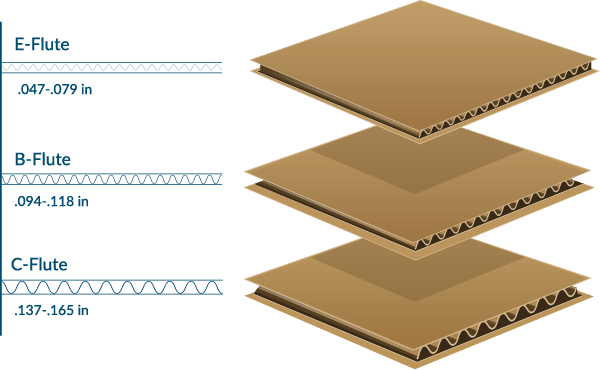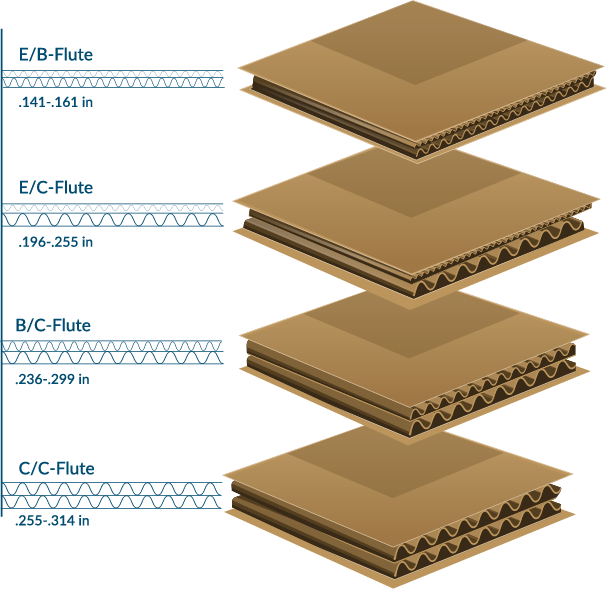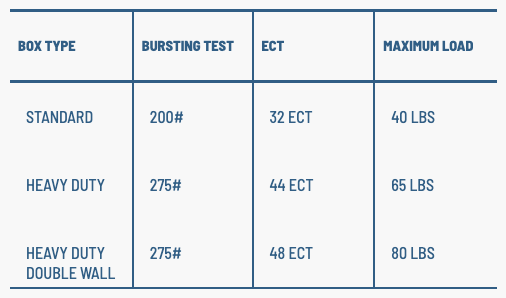You invest a lot to make sure every product that comes off the line is quality.
But even though you don’t control what happens to it after you ship it out the door, your customers still expect to receive undamaged products. Which is why choosing the right grades of corrugated fiberboard for your packaging is essential.
You need your boxes to protect against transport shocks, stacking pressure, humidity, and more. But you also need to keep packaging costs in budget.
This guide walks you through choosing the right board grades to strike that balance.
But first it’s important to understand how companies are losing money by choosing the wrong grades of corrugated.
How the Wrong Fiberboard Grades Cost You Money
When you’re ordering packaging you want to minimize the cost while maximizing the benefits to the company.
But the costs of using the wrong corrugated fiberboard grade aren’t always clear. Here are the two main ways your board grade could be costing you money.
The Cascading Costs of Shipping Damage
A dented box or a crushed pallet might seem like a simple fix. Just send out a replacement and maybe file a claim with your shipping company.
But each damaged shipment has a costly ripple effect.
Extra labor hours dealing with customer service and reshipments. Lost sales from customers who decide to switch vendors. Even a damaged reputation that limits future opportunities.
The Quiet Cost of Over-Engineered Boxes
One way to prevent shipping damage is to use the strongest materials available.
This won’t cause customer complaints, but if your shipments don’t actually need that level of strength then you’re spending extra money on every box without much—if any—extra benefit.
The key is to find the goldilocks solution: Strong enough to handle the job. But not spending more than you have to.
To do that, you need a solid understanding of the different corrugated board grades available.
Corrugated Fiberboard Grades: Master the Basics for Smart Decision Making
The truth is that you shouldn’t have to become a packaging engineer to get your products shipped safely.
So we’ve put together a solid primer to get you up to speed on the most important aspects you need to make the right decisions for your packaging.
Your corrugated board grade depends on three factors: the liner, the fluting, and the walls.
The Flutes
Flutes are the layers of wavy paper that give corrugated board its protective powers.
The main thing to focus on with fluting is its size.
In general, larger fluting gives you more structural integrity, cushioning, and insulation. Here are some common flute sizes:

Larger flutes, like C-Flute, are ideal for boxing heavy or fragile products for transport. While smaller flutes, like E-Flute, offer a more ideal printing surface for things like retail packaging.
The Liner
The fluting is lined with paper on the outer and inner surfaces—and between walls if you’re using double-wall board.
The main things to focus on with the liner are:
- Color
- Content
- Weight
Typical liner colors before printing are brown (kraft) or white.
Content ranges from virgin wood pulp, which offers the most strength and protection, to mostly recycled content, which is often less expensive.
And liner weights range from 125 grams per square meter (gsm) all the way to 300 gsm, with heavier liners adding more to the structural integrity of your boards.
The Walls
Most corrugated boxes have a single layer of fluting. But for added protection you can choose boards with two layers, or “walls.”
Here are some examples of common double-wall combinations:

By combining different fluting sizes you can take advantage of the best properties of each. So E/B-Flute, for example, let’s you optimize for both printing and protection.
Putting It All Together
The combination of fluting size, liner type, and wall count determines a board’s overall “grade.”
But which grade you should choose depends on several factors:
- Product Weight
- Product Fragility
- Transit Time and Conditions
- Warehouse Stacking Height
- Warehouse Climate Conditions
- Number of Load/Unload Cycles
Our in-house structural designers have helped hundreds of companies strike the right balance of protection and cost for each application.
For example, you might have products in retail ready packaging boxed up in larger transit boxes that will ship internationally. In that case you could choose:
- Transit Boxes - Optimize for Strength: B/C-Flute with 150 gsm virgin outer liner with 150 gsm recycled interior liners
- Retail-Ready Boxes - Optimize for Printing: E-Flute with white 125 gsm virgin out liner and white 125 gsm recycled interior liner
That way you keep production costs in check while also cutting down on costly shipping damage.
How to Know Your Boxes are Strong Enough
As you can see, there are a lot of variables that go into selecting the right board grades.
Which is why it takes a mix of experience, expertise, and objective benchmarks to make sure your boxes will keep your products intact and undamaged during transit.
Get Input from Experienced Structural Designers
You shouldn’t have to study box engineering to choose corrugated grades.
Our in-house structural designers fine-tune the right fluting, board grade, and closure methods (like glued seams or reinforced corners) for you, so your boxes can handle the stress of transit and storage without leaning too heavily on high-end materials.
And we make sure they pass all retailer standards with flying colors.
Tests and Benchmarks
Industry tests such as the Edge Crush Test (ECT) offer measurable proof of a board’s stacking strength or puncture resistance.
Compression tests can simulate warehouse stacking pressures, showing if your chosen grade holds up under realistic conditions. Here are some basic benchmarks to help guide your decision making:

Our structural designers make sure your boxes meet the necessary benchmarks to fully protect your products.
Escape the Quality Trap
No matter how much expertise and testing you put into choosing the right board grades, poor quality control from your vendor will tank your cost savings.
You end up paying for stronger materials and still incurring costs for damaged shipments.
We’ve spent decades building supply chains and manufacturing standards that guarantee excellent corrugated boxes. In fact we recently invested in our own 110” corrugator to ensure a consistent supply of top-quality materials for your boxes.
Choosing a vendor who delivers quality every time saves you money and hassle month after month.
Get Quality Boxes that Save You Money and Keep Customers Happy
Choosing the right corrugated board grade is complex—but it shouldn’t be hard.
Our structural designers have it down to a science. They spend every day putting together the right materials and box designs to satisfy both physics and your budget.
Manufacturers have enough plates to keep spinning. So we’ve built a whole suite of services to make packaging the easiest, most reliable part of your business.
If you’re ready for a packaging partner to make the hard parts easy, get in touch today and we’ll show you what’s possible.


